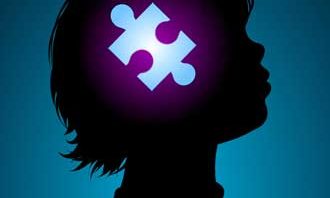Introduction to Autism
Autism spectrum disorder (ASD) is a group of various developmental disabilities defined by impaired social interaction and communication, characterized by subjects with narrow interests. However, biological mechanisms were not recognized with Autism until the 1980s, when studies demonstrated the high heritability of ASD and its connection with other genetic conditions. This provided compelling evidence for the role of genetics with Autism, and fueled research up to today on the neurologic causation of this disorder.
Diagnosis
Diagnosis of Autism spectrum disorder is based on the presence of two major symptoms: social-communication deficits and limited and repetitive interests/behaviors. These symptoms must be exhibited in early childhood, but additional symptoms include sensory and motor deficiencies, sleep disturbance, epilepsy, attention deficit/hyperactivity disorder, intellectual disability, anxiety and aggression. Autism prevalence has grown year to year for decades, with a prevalence of 1% worldwide today.
Genetics
It is widely understood ASD contains a huge genetic component. The concordance rates of autism are approximately 90% in monozygotic twins and 10% in dizygotic twins. However, Autism is rarely defined by a single genetic mutation, as these instances only account for 1-2% of Autism cases. Therefore, autism research has focused on genome-wide association studies, accounting for a wide range of genes and how multiple mutations can predispose Autism. Many recent discoveries relating to autism have been titled de novo mutations in genes that encode synaptic proteins and neuroligins. Additionally, several mutations of ASD are indicators for other psychological disorders such as intellectual disability, schizophrenia, childhood absence epilepsy, ADHD and depression.
Neuroanatomical Abnormalities
A common alteration in brain anatomy seen in about 20% of autistic children is macrocephaly, or overgrowth of the brain. Localized overgrowth and over-dendritic development has been identified in the frontrol lobe, parieto-temporal lobe, cerebellum, and subcortical limbic structures. Most notably, the cerebellum has is a main focus of neuroanatomical abnormalities in autistic subjects. Magnetic resonance imaging (MRI) have suggested hypoplasia throughout the cerebellum and most notably a reduction in Purkinje cells. Purkinje cell fibers have a very significant role in regulation of motor movements, helping the fluidity of all physical movement. Therefore, many autistic patients have sensory and motor dysfunctions. It has also been found that cerebellar activation is significantly reduced during selective attention tasks, whereas it is enhanced during a simple motor task in autistic individuals. Cerebellum dysfunction has also been shown to be associated with core symptoms of autism. Recent research has suggested Purkinje cells play a role in social functioning, and neurotransmitter communication throughout the brain. By finding this Purkinje cell role, the mechanism of autism spectrum disorder has further been clarified.
Neurotransmitter Abnormalities
Defects in excitatory/inhibitory balance throughout the brain occurs in patients with autism. Common defects in synaptic proteins in ASD leads to defective transmission in excitatory and inhibitory synapses, damaging the E-I balance throughout structures of the brain. Reduced levels of glutamate, an excitatory neurotransmitter, were observed in the plasma of autistic children, also indicated in post-mortem brains of autistic patients. Decreased levels of rate-limiting enzyme for synthesis of GABA was also observed in autistic brains, suggesting an excess of this inhibitory neurotransmitters.
 Serotonin is a neurotransmitter known to play a role in regulating E-I balance. Increased levels of serotonin (5-HT) were observed in blood and urine of autistic individuals. Various genes encoding for serotonergic signaling are linked to autism, like the gene encoding for the serotonin transporter 5-HTT.
Serotonin is a neurotransmitter known to play a role in regulating E-I balance. Increased levels of serotonin (5-HT) were observed in blood and urine of autistic individuals. Various genes encoding for serotonergic signaling are linked to autism, like the gene encoding for the serotonin transporter 5-HTT.
Lastly, proteins vital for pre-synaptic release are altered in autistic patients. Neurexins and neuroligins also regulate various aspects of both excitatory and inhibitory synaptic development and function. Many mutations in genes encoding neurexins and neuroligins have been associated with Autistic Spectrum disorder.
Overall, many complex neurological complications are present in autism, often stemming from genetic origin. By better understanding the factors in play in autism, one can better discern the nature of this condition, and become aware of psychological conditions.
Breaking down Autism
